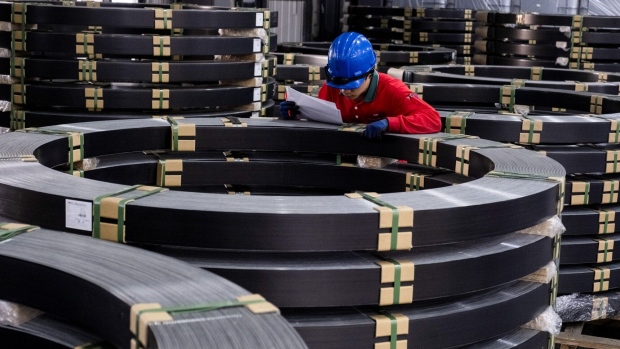May 1, 2024
Taiwan Halts Two-Year Factory Slump in Sign of Broader Rebound
, Bloomberg News

(Bloomberg) -- Taiwan’s factory activity expanded for the first time in two years, bolstering Asia’s manufacturing heft as demand for the region’s goods begins to firm up.
The semiconductor powerhouse posted a manufacturing purchasing managers’ index of 50.2 last month, up from 49.3 in March and posting its best result since April 2022, according to data published Thursday by S&P Global. A reading above 50 indicates expansion, while anything below shows contraction.
Taiwan ramped up output amid higher new orders, with companies reporting improved demand from the domestic market, S&P said. Overseas take-up was still subdued, though, so firms remained “understandably somewhat cautious” in their buying activity, opting instead to use their inventories, according to S&P.
“That said, companies are confident that growth will pick up and were sufficiently optimistic to add to their staffing levels for the third time in the past four months,” Paul Smith, economics director at S&P Global Market Intelligence, said in a statement.
The latest data show that Asia may have finally found steadier footing after its economies had to grapple with Red Sea supply chain disruptions, along with rising food and fuel costs. High interest rates and lackluster economic growth likewise undercut demand in key markets like the US and Europe.
There are reasons for optimism across North Asia. China’s recovery seems to be gaining ground as it posted consecutive months of growing factory activity. Its official PMI stayed above the 50 line although it eased slightly to 50.4 in April, while a private gauge that tracks smaller and more export-oriented firms was even higher at 51.4, according to data Tuesday.
Japan also inched closer to the 50 mark that separates expansion and contraction, signaling its factory activity may soon exit a yearlong slump. Its PMI climbed to 49.6 in April, its highest reading since August, au Jibun Bank’s survey showed on Wednesday.
Neighboring South Korea, however, pulled back slightly, with a PMI of 49.4 last month from 49.8 in March, it reported Thursday. In Southeast Asia, Indonesia, the Philippines and Vietnam all posted expansionary factory activities while Thailand and Malaysia were laggards at 48.6 and 49 respectively.
Inflation remains a risk to Asia’s turnaround as most factories cited elevated raw materials, oil and logistics costs dampening production. Input price inflation hit a five-month high in South Korea. In Indonesia, the rupiah’s sharp decline further bloated the price of imported goods.
(Updates with Southeast Asia data and chart.)
©2024 Bloomberg L.P.





